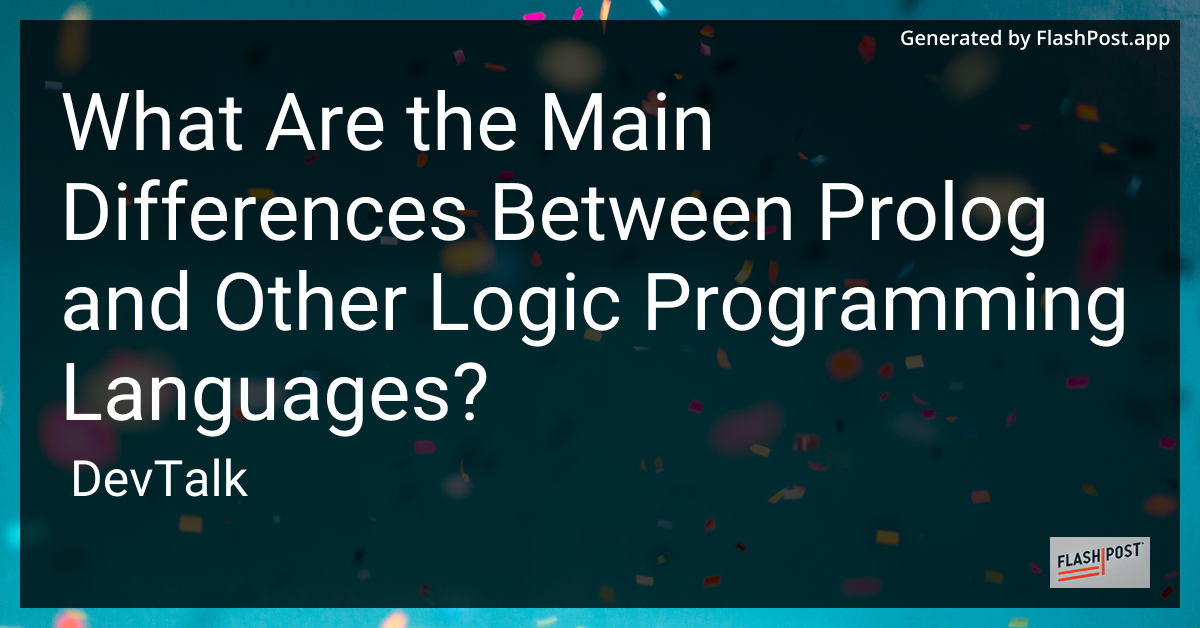What Are the Main Differences Between Prolog and Other Logic Programming Languages?

Understanding the Main Differences Between Prolog and Other Logic Programming Languages
Logic programming is a powerful paradigm used in computer science that is rooted in formal logic.
Among the various logic programming languages, Prolog stands out as one of the most popular and widely used. This article aims to explore the key differences between Prolog and other logic programming languages, shining a light on what makes Prolog unique.
Prolog: An Overview
Prolog, short for "Programming in Logic," was created in the early 1970s as a way to support natural language processing. It is based on predicate calculus and is declarative in nature, allowing programmers to specify what the program should accomplish rather than detailing how to achieve it. This is achieved through facts, rules, and queries built on a logical framework.
Key Differences Between Prolog and Other Logic Programming Languages
1. Syntax and Semantics
-
Prolog has a unique syntax that uses predicates, facts, and rules to express logic. This structure allows for concise representation of rules and knowledge bases. It also employs backtracking to find solutions, which distinguishes its operational semantics from other logic languages.
-
Other Logic Languages may adopt different syntactical approaches. For example, ASP (Answer Set Programming) represents logic programs in terms of stable models or answer sets, which differs fundamentally from Prolog's approach.
2. Backtracking Mechanism
-
Prolog heavily relies on backtracking to explore different possibilities in search of a solution. When a condition is not satisfied, Prolog automatically backtracks to try other alternatives. This feature is intrinsic to Prolog and is one of its most powerful attributes.
-
Other Logic Languages such as Mercury and Datalog may not implement backtracking in the same way or to the same extent, leading to differences in how solutions are derived.
3. Use of Lists and Recursion
-
Prolog excels in handling lists and recursion, which is crucial for many logic programming tasks. The ability to easily manipulate lists and implement recursive strategies is a hallmark of Prolog's utility.
-
Other Logic Languages may offer different constructs or abstractions for lists and recursion. For instance, they might provide more complex data structures or different algorithmic strategies, affecting performance and design.
4. Integration Capabilities
-
Prolog can be integrated with other languages and technologies, making it versatile for applications needing logic-based solutions. Its simplicity and efficiency appeal to both academic research and practical applications.
-
Other Logic Languages might have different integration capabilities, affecting usability in various technological stacks. Some may excel in specific domains like databases or artificial intelligence, offering tailored functionalities outside the scope of traditional Prolog use cases.
5. Learning Curve and Community Support
-
Prolog is supported by a rich history and community, providing a plethora of programming identifiers, tutorials, and tips for learners and developers to leverage. Its straightforward declarative approach appeals to beginners who might find imperative languages daunting.
-
Other Logic Languages may have steeper learning curves or less comprehensive community support depending on their age and use cases.
Conclusion
Prolog distinguishes itself from other logic programming languages through its intuitive syntax, robust backtracking mechanism, and strong community support. For those interested in delving deeper into Prolog's capabilities, there are plenty of resources available to enhance your understanding and skills. Additionally, you can explore tutorials on creating lists and more within the Prolog language environment.
Whether you are a seasoned developer or a curious learner, understanding these differences is key to harnessing the full potential of Prolog and other logic programming languages in solving complex problems.